- Preface
- Introduction to Cisco vWAAS
- Configuring Cisco vWAAS and Viewing vWAAS Components
- Cisco vWAAS on Cisco ISR-WAAS
- Cisco vWAAS on VMware ESXi
- Cisco vWAAS on Microsoft Hyper-V
- Cisco vWAAS on RHEL KVM and KVM CentOS
- Cisco vWAAS on Cisco ENCS 5400-W Series
- Cisco vWAAS with Cisco Enterprise NFVIS
- Cisco vWAAS with Akamai Connect
- Cisco vWAAS in Cloud Computing Systems
- Troubleshooting Cisco vWAAS
Cisco vWAAS on VMware ESXi
This chapter describes how to use Cisco vWAAS on VMware vSphere ESXi, and contains the following sections:
About Cisco vWAAS on VMware ESXi
Cisco vWAAS for VMware ESXi provides cloud-based application delivery service over the WAN in ESX/ESXi-based environments. Cisco vWAAS on VMware vSphere ESXi is delivered an OVA file. The vSphere client takes the OVA file for a specified vWAAS model, and deploys an instance of that vWAAS model.
Supported Host Platforms, Software Versions, and Disk Type
Table 4-1 shows the platforms and software versions supported for vWAAS on VMware ESXi.
Table 4-1 Platforms and Software Versions Supported for vWAAS on VMware ESXi
|
|
|
|
|
|
|---|---|---|---|---|
VMware ESXi for Cisco vWAAS and Cisco WAAS
VMware ESXi Versions Supported for Cisco WAAS
Table 4-2 VMware ESXi Versions Supported for Cisco WAAS
|
|
|
|
|
|
|
|
|---|---|---|---|---|---|---|

Note![]() For vWAAS with ESXi Version 5.5 on a Cisco UCS host: if the DRE latency threshold or an AO timeout alarm occurs, check for the I/O command abort in the vWAAS. To do this, use the copy sysreport EXEC command.
For vWAAS with ESXi Version 5.5 on a Cisco UCS host: if the DRE latency threshold or an AO timeout alarm occurs, check for the I/O command abort in the vWAAS. To do this, use the copy sysreport EXEC command.
If the I/O abort is observed:
Upgrade the RAID controller’s driver to Version 6.610.19.00 or later.
If the I/O abort is still observed after the RAID controller driver upgrade:
Capture and share the following logs for further analysis:
—Guest-VM sysreport
—VMware’s host diagnostic report
—RAID controller’s firmware log
ESXi Server Datastore Memory and Disk Space for vWAAS and vCM Models
This section contains the following topics:
- Table 4-3 shows ESXi server datastore memory and disk space per vWAAS model, for WAAS v4.3.1 through v5.3.5, and for WAAS v5.4.x through v6.x.
- Table 4-4 shows ESXi server datastore memory and disk space per vCM model, for WAAS v4.3.1 through v5.3.5, and for WAAS v5.4.x through v6.x.
Table 4-3 vCPUs, ESXi Server Datastore Memory, and Disk Space by vWAAS Model
|
|
|
|||||
|---|---|---|---|---|---|---|
|
|
|
|
|
|
|
|
Table 4-4 vCPUs, ESXi Server Datastore Memory, and Disk Space by vCM Model
|
|
|
|||||
|---|---|---|---|---|---|---|
|
|
|
|
|
|
|
|
OVA Package Formats for vWAAS on VMware ESXI
This section contains the following topics:
- OVA Package for vWAAS on VMware ESXi for WAAS Version 5.x to 6.2.x
- OVA Package for vWAAS on VMware ESXi for WAAS Version 6.4.1 and Later

Note![]() For a listing of hypervisor OVA, zip, and tar.gz files for vWAAS, see the Cisco Wide Area Application Services (WAAS) Download Software Page and select the WAAS software version used with your vWAAS instance.
For a listing of hypervisor OVA, zip, and tar.gz files for vWAAS, see the Cisco Wide Area Application Services (WAAS) Download Software Page and select the WAAS software version used with your vWAAS instance.
OVA Package for vWAAS on VMware ESXi for WAAS Version 5.x to 6.2.x
For vWAAS on VMware ESXi, for WAAS Version 5.x through 6.2.x, Cisco provides an OVA or NPE OVA package for each vWAAS connection profile (examples shown in Table 4-5) and for each vCM connection profile (examples shown in Table 4-6).
Table 4-5 Cisco OVA Package Format Examples for vWAAS on VMware ESXi
|
|
|
|---|---|
Table 4-6 Cisco OVA Package Formats for vCM for WAAS Versions earlier than Version 6.4.1
|
|
|
|---|---|
OVA Package for vWAAS on VMware ESXi for WAAS Version 6.4.1 and Later
For vWAAS on VMware ESXi, for WAAS Version 6.4.1 and later, Cisco provides a single, unified OVA for NPE and non-NPE version of the WAAS image for all the vWAAS models for that hypervisor.
Each unified OVA package is a pre-configured virtual machine image that is ready to run on a particular hypervisor. The launch script for each unified OVA package file provides the model and other required parameters to launch vWAAS with WAAS in the required configuration.
Here are examples of the unified OVA and NPE OVA package filenames for vWAAS in VMware ESXi:
The unified OVA package for VMware ESXi contains the following files.
Use the VMware ESXi OVF template wizard to deploy these files, described in Installing VMware ESXi for vWAAS for WAAS Version 6.4.1 and Later.
Installing vWAAS on VMware ESXi
This section has the following topics:
- Installing VMware ESXi for vWAAS for WAAS Versions 5.x to 6.2.x
- Installing VMware ESXi for vWAAS for WAAS Version 6.4.1 and Later
Installing VMware ESXi for vWAAS for WAAS Versions 5.x to 6.2.x
To install the vWAAS Virtual Machine (VM) with VMware vSphere ESXi, follow these steps:
Step 1![]() From the vSphere Client, choose File > Deploy OVF Template.
From the vSphere Client, choose File > Deploy OVF Template.
The Source window appears (Figure 4-1).
Figure 4-1 vWAAS - Deploy OVF Template

Step 3![]() Navigate to the location of the vWAAS OVA file and click Open.
Navigate to the location of the vWAAS OVA file and click Open.
- If the virtual host was created using an OVA of vWAAS for WAAS Version 5.1.x or later, proceed to Step 4.
- If the virtual host was created using an OVA file of vWAAS for WAAS Version 5.0 or earlier, and you have upgraded vWAAS from inside WAAS, you must verify that the SCSI Controller Type is set to VMware Paravirtual. Otherwise, vWAAS will boot with no disk available, and will fail to load the specified configuration.
If needed, change the SCSI controller type to VMware Paravirtual by following these steps:
b.![]() From the VMware vCenter, navigate to vSphere Client > Edit Settings > Hardware.
From the VMware vCenter, navigate to vSphere Client > Edit Settings > Hardware.
d.![]() From the Change Type drop-down list, verify that the SCSI Controller Type is set to VMware Paravirtual. If this is not the case, choose VMware Paravirtual.
From the Change Type drop-down list, verify that the SCSI Controller Type is set to VMware Paravirtual. If this is not the case, choose VMware Paravirtual.
f.![]() Power up the vWAAS, with WAAS Version 6.1.x or later.
Power up the vWAAS, with WAAS Version 6.1.x or later.
Step 4![]() Click Next to accept the selected OVA file.
Click Next to accept the selected OVA file.
The Name and Location window appears.
Step 5![]() Enter a name for the vWAAS VM, choose the appropriate data center, and then click Next.
Enter a name for the vWAAS VM, choose the appropriate data center, and then click Next.
The Cluster window appears (if a cluster is configured), or the Resource Pool window appears (if a resource pool is configured). Otherwise, the Datastore window appears (in this case, skip to Step 7).
Figure 4-2 vWAAS - Name and Data Center Location

Step 6![]() If configured, choose a cluster for the vWAAS VM or, if configured, choose the resource pool and then click Next.
If configured, choose a cluster for the vWAAS VM or, if configured, choose the resource pool and then click Next.
Step 7![]() Choose a datastore to host the virtual machine and click Next.
Choose a datastore to host the virtual machine and click Next.


Note![]() The datastore must be formatted with a block size greater than 1 MB to support file sizes larger than 256 GB.
The datastore must be formatted with a block size greater than 1 MB to support file sizes larger than 256 GB.
The Create a Disk window appears.
Step 8![]() The Disk Provisioning section has three disk format options: Thick Provision Lazy Zeroed, Thick Provision Eager Zeroed, and Thin Provision. Select Thick Provision Eager Zeroed.
The Disk Provisioning section has three disk format options: Thick Provision Lazy Zeroed, Thick Provision Eager Zeroed, and Thin Provision. Select Thick Provision Eager Zeroed.

Note![]() You must choose the Thick Provision Eager Zeroed disk format for vWAAS deployment; this is the format recommended with vWAAS deployment for a clean installation.
You must choose the Thick Provision Eager Zeroed disk format for vWAAS deployment; this is the format recommended with vWAAS deployment for a clean installation.
The Network Mapping window appears.
Step 10![]() Choose the network mapping provided by ESXi and click Next. You have the option to change this later if necessary.
Choose the network mapping provided by ESXi and click Next. You have the option to change this later if necessary.
The Ready to Complete window appears.
Figure 4-4 vWAAS - Network Mapping

Step 11![]() Click Finish to complete the installation.
Click Finish to complete the installation.
The status window appears while the OVA file is being deployed.
Figure 4-5 vWAAS - Status Window

Step 12![]() When the deployment is finished, the Deployment Completed Successfully window appears.
When the deployment is finished, the Deployment Completed Successfully window appears.

Step 14![]() You are ready to start the VM. Highlight the vWAAS VM and click Power on Virtual Machine.
You are ready to start the VM. Highlight the vWAAS VM and click Power on Virtual Machine.
Step 15![]() After vWAAS finishes booting, click the Console tab to view boot up messages.
After vWAAS finishes booting, click the Console tab to view boot up messages.


Note![]() Under rare conditions, the vWAAS VM may boot into diskless mode if other VMs on the host VM server do not release control of system resources or the physical disks become unresponsive. For information on how to resolve this situation, see Resolving Diskless Startup and Disk Failure in Chapter 10, “Troubleshooting Cisco vWAAS.”
Under rare conditions, the vWAAS VM may boot into diskless mode if other VMs on the host VM server do not release control of system resources or the physical disks become unresponsive. For information on how to resolve this situation, see Resolving Diskless Startup and Disk Failure in Chapter 10, “Troubleshooting Cisco vWAAS.”
For vWAAS configuration information, see Chapter 2, “Configuring Cisco vWAAS and Viewing vWAAS Components” .
Installing VMware ESXi for vWAAS for WAAS Version 6.4.1 and Later
vWAAS for WAAS Version 6.4.1 and later supports VMware vCenter Version 6.0.0. To deploy any vWAAS or vCM Model for WAAS Version 6.4.1 and later on VMware ESXi, register the ESXi host with VMware vSphere vCenter version 6.0.

Note![]() The OVA deployment for WAAS Version 6.4.1 and later must be done only through VMware vCenter.
The OVA deployment for WAAS Version 6.4.1 and later must be done only through VMware vCenter.
To deploy the VMware ESXi hypervisor for vWAAS for WAAS Version 6.4.1 and later, follow these steps:
Step 1![]() Log in into the VMware vCenter using VMware vSphere Client (Figure 4-8).
Log in into the VMware vCenter using VMware vSphere Client (Figure 4-8).
Figure 4-8 VMware vSphere Client Login Window
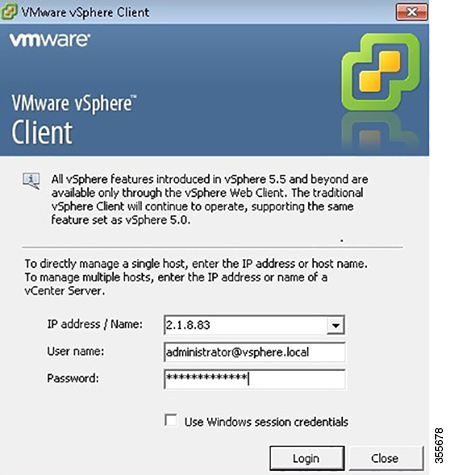
Step 2![]() To begin the task of adding the ESXi host into the datacenter on VMware vCenter Client, you must first create a datacenter. Navigate to Actions > New Datacenter....
To begin the task of adding the ESXi host into the datacenter on VMware vCenter Client, you must first create a datacenter. Navigate to Actions > New Datacenter....
Step 3![]() At the Create Datacenter page, click Add.
At the Create Datacenter page, click Add.
Step 4![]() In the Create Datacenter dialog box:
In the Create Datacenter dialog box:
a.![]() In the Name field enter a name for the datacenter. The name can contain up to 16 alphanumeric characters with no spaces and no special characters.
In the Name field enter a name for the datacenter. The name can contain up to 16 alphanumeric characters with no spaces and no special characters.
b.![]() In the Description field enter a description for this datacenter.
In the Description field enter a description for this datacenter.
Step 5![]() To add the host into the datacenter on VMware vCenter Client, navigate to the Getting Started tab > Add Host... menu selection (Figure 4-9).
To add the host into the datacenter on VMware vCenter Client, navigate to the Getting Started tab > Add Host... menu selection (Figure 4-9).
Figure 4-9 Add Host... Menu Selection
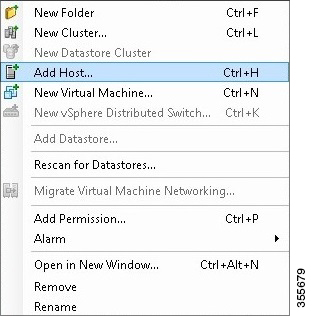
Step 6![]() Choose Specify Connection Settings and the Specify Connection Settings window appears (Figure 4-10).
Choose Specify Connection Settings and the Specify Connection Settings window appears (Figure 4-10).
Figure 4-10 Specify Connection Settings Window

a.![]() In the Connection pane Host field, enter the ESXi host name or IP address.
In the Connection pane Host field, enter the ESXi host name or IP address.
b.![]() In the Authorization pane Username and Password fields, enter the ESXi username and password.
In the Authorization pane Username and Password fields, enter the ESXi username and password.
Step 7![]() The Host Information window appears (Figure 4-11), which displays information you can review for the specified host, including host name or IP address, vendor name, model name and number, the VMware version, and the associated virtual machines.
The Host Information window appears (Figure 4-11), which displays information you can review for the specified host, including host name or IP address, vendor name, model name and number, the VMware version, and the associated virtual machines.
Figure 4-11 Host Information Window
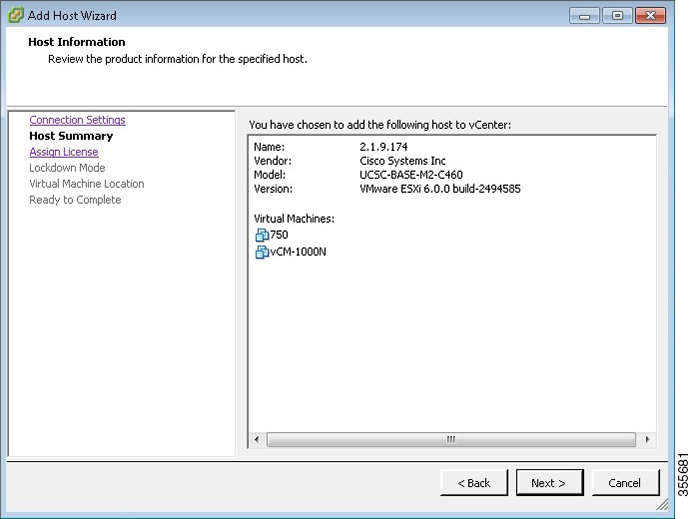
a.![]() If the displayed host information meets your system requirements, click Next.
If the displayed host information meets your system requirements, click Next.
Step 8![]() The Assign License window appears (Figure 4-12).
The Assign License window appears (Figure 4-12).
Figure 4-12 Assign License Window
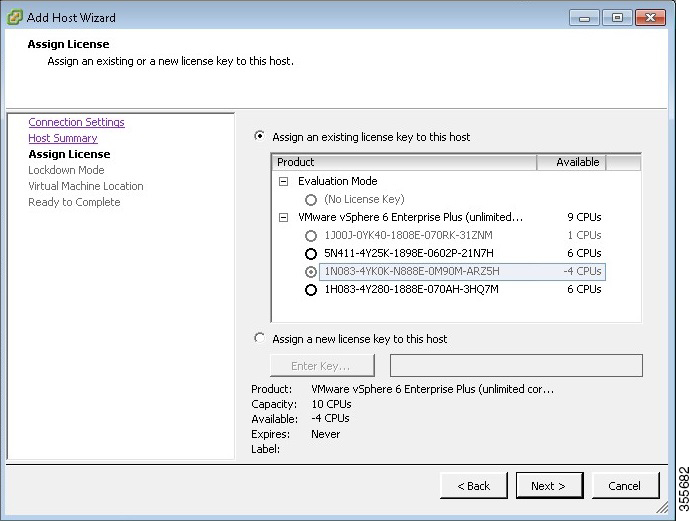
a.![]() Using one of the radio buttons, assign an existing license key to this host or assign a new license key to this host.
Using one of the radio buttons, assign an existing license key to this host or assign a new license key to this host.

Note![]() Licenses are installed and managed only on individual devices, not device groups. For more information about licenses, see the “Configuring Other System Settings” chapter, section “Managing Software Licenses” of the Cisco Wide Area Application Services Configuration Guide.
Licenses are installed and managed only on individual devices, not device groups. For more information about licenses, see the “Configuring Other System Settings” chapter, section “Managing Software Licenses” of the Cisco Wide Area Application Services Configuration Guide.
Step 9![]() The Configure Lockdown Mode window appears (Figure 4-13).
The Configure Lockdown Mode window appears (Figure 4-13).
Figure 4-13 Configure Lockdown Mode Window
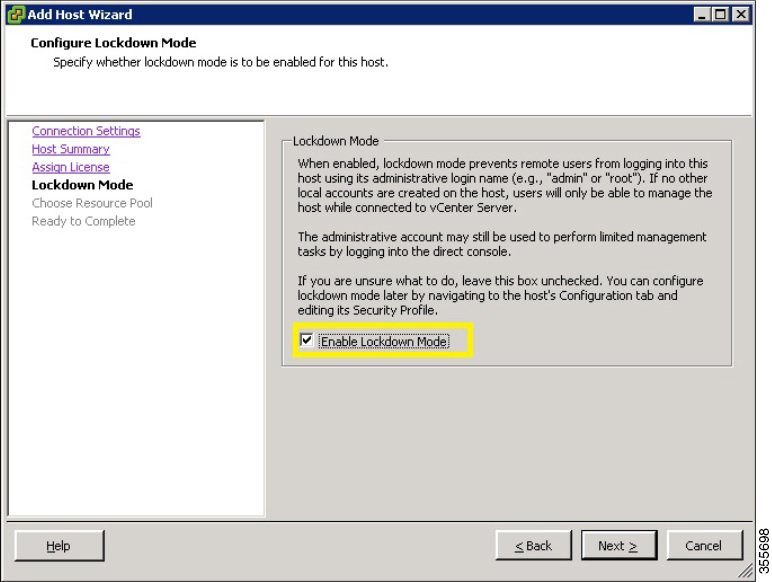
Step 10![]() Lockdown mode is disabled by default.
Lockdown mode is disabled by default.
When lockdown mode is disabled, all router and module communication commands behave normally.
When lockdown mode is enabled, the VMware vSphere Hypervisor host can be only be managed by the VMware vCenter Server using its internal user called vpxuser. All other configuration methods, such as the vSphere Client, PowerCLI, and vCLI are disabled.
Step 12![]() The Virtual Machine Location window appears (Figure 4-14).
The Virtual Machine Location window appears (Figure 4-14).
Figure 4-14 Virtual Machine Location Window
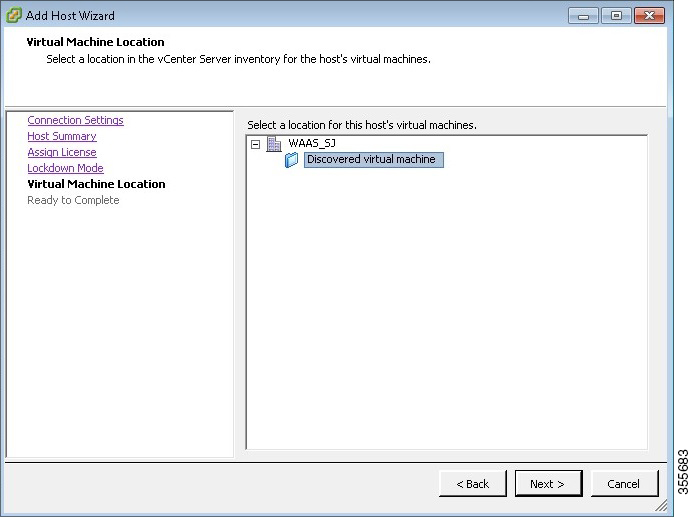
a.![]() Select a location in the vCenter Server Inventory for the specified host’s virtual machines.
Select a location in the vCenter Server Inventory for the specified host’s virtual machines.
Step 13![]() The vSphere Client window is displayed with the Recent Tasks pane displaying a Completed status for this task (Figure 4-15).
The vSphere Client window is displayed with the Recent Tasks pane displaying a Completed status for this task (Figure 4-15).
Figure 4-15 vSphere Client Recent Tasks Pane

Step 14![]() Navigate to File > Deploy OVF Template... (Figure 4-16).
Navigate to File > Deploy OVF Template... (Figure 4-16).
Figure 4-16 Deploy OVF Template... Menu Selection

Step 15![]() Download the vWAAS OVA from the Cisco Wide Area Application Services (WAAS) Download Software Page.
Download the vWAAS OVA from the Cisco Wide Area Application Services (WAAS) Download Software Page.
Step 16![]() Navigate to File > Deploy OVF Template... > Source.
Navigate to File > Deploy OVF Template... > Source.
Step 17![]() The Source window appears (Figure 4-17), where you select the OVA file.
The Source window appears (Figure 4-17), where you select the OVA file.
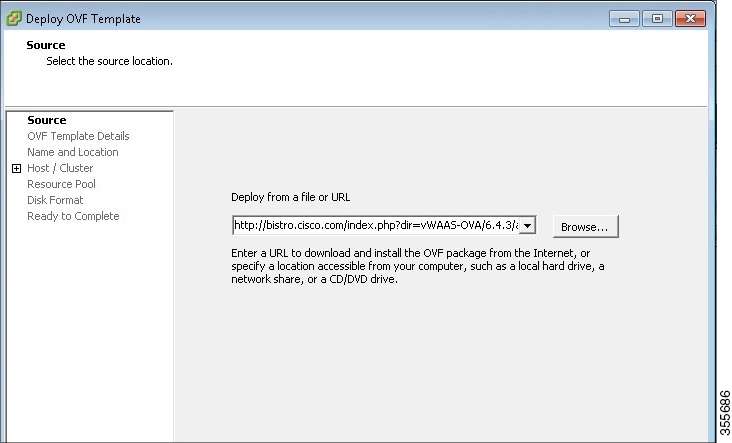
a.![]() From the Deploy from a file or URL drop-down list, select the OVA file.
From the Deploy from a file or URL drop-down list, select the OVA file.
Step 18![]() The OVF Template Details window appears (Figure 4-18), where you can verify the OVF template details including product name, version, vendor, download size, size on disk, and a description.
The OVF Template Details window appears (Figure 4-18), where you can verify the OVF template details including product name, version, vendor, download size, size on disk, and a description.
Figure 4-18 OVF Template Details Window
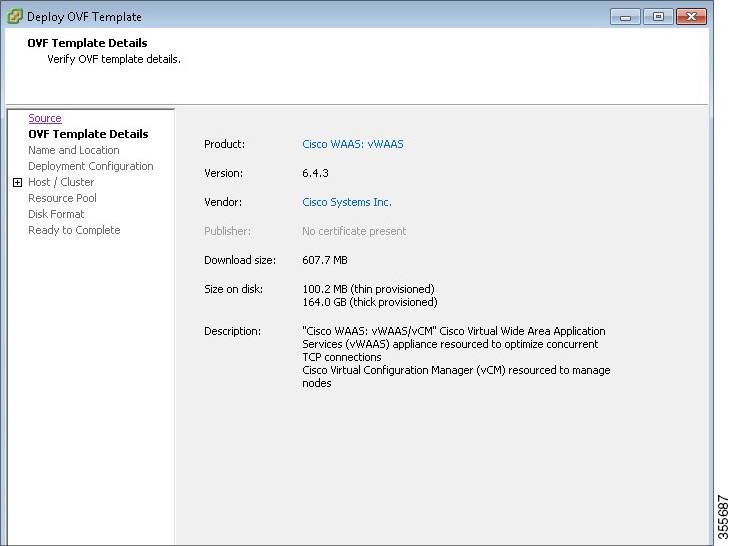
a.![]() To accept the selected OVA file, click Next.
To accept the selected OVA file, click Next.
Step 19![]() The Name and Location window appears (Figure 4-19), where you specify a name and location for the deployed template.
The Name and Location window appears (Figure 4-19), where you specify a name and location for the deployed template.
Figure 4-19 Name and Location Window
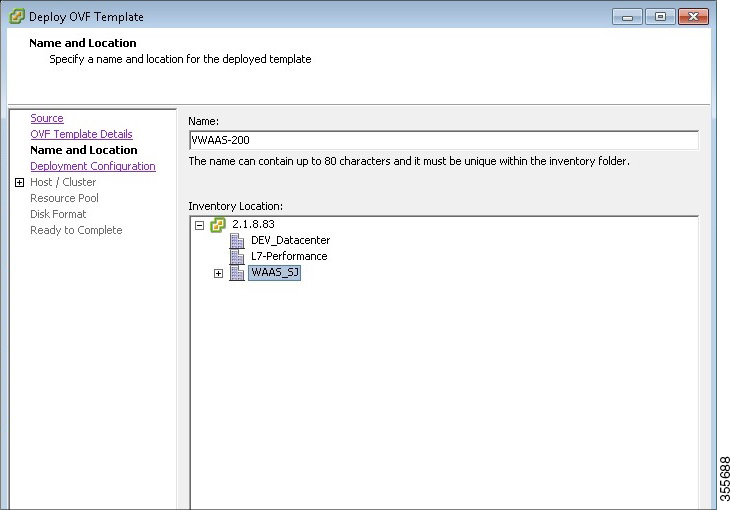
a.![]() In the Name field, enter the name for the vWAAS VM.
In the Name field, enter the name for the vWAAS VM.
b.![]() At the Inventory Location listing, select the location to deploy (datacenter).
At the Inventory Location listing, select the location to deploy (datacenter).
Step 20![]() The Deployment Configuration window appears (Figure 4-20).
The Deployment Configuration window appears (Figure 4-20).
Figure 4-20 Deployment Configuration Window
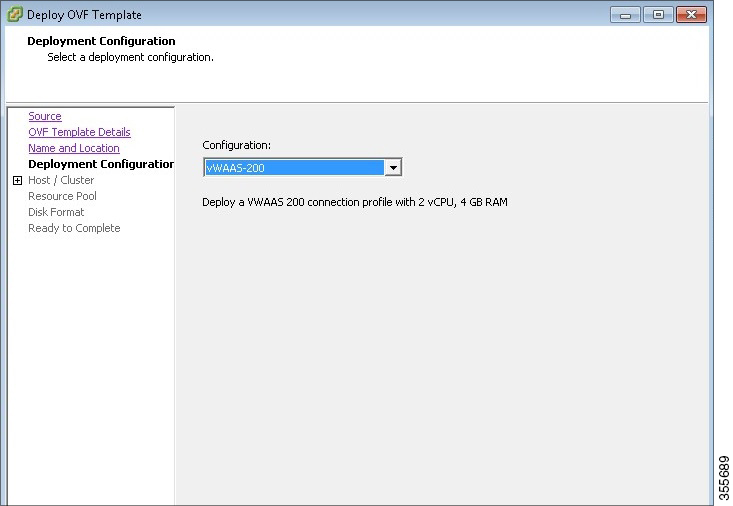
a.![]() From the Configuration drop-down list, choose the vWAAS model to deploy. After you choose a vWAAS model, the window displays a description of the vWAAS model, such as “Deploy a vWAAS-200 connection profile with 2 vCPU, 4 GB RAM.”
From the Configuration drop-down list, choose the vWAAS model to deploy. After you choose a vWAAS model, the window displays a description of the vWAAS model, such as “Deploy a vWAAS-200 connection profile with 2 vCPU, 4 GB RAM.”
Step 21![]() The Host/Cluster window is displayed (Figure 4-21), where you can choose a host or cluster to run the deployed template.
The Host/Cluster window is displayed (Figure 4-21), where you can choose a host or cluster to run the deployed template.
Figure 4-21 Host/Cluster Window

a.![]() Select the ESXi host or cluster where you need to run the deployed template.
Select the ESXi host or cluster where you need to run the deployed template.
Step 22![]() The Disk Format window is displayed (Figure 4-22), which displays data store address and available disk space, in GB, and provisioning choices.
The Disk Format window is displayed (Figure 4-22), which displays data store address and available disk space, in GB, and provisioning choices.
Figure 4-22 Disk Format Window
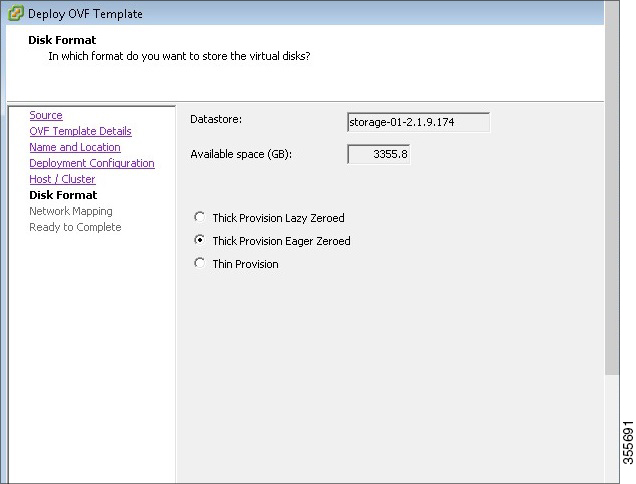

Note![]() You must choose Thick Provision Eager Zeroed for vWAAS deployment.
You must choose Thick Provision Eager Zeroed for vWAAS deployment.
Step 23![]() The Network Mapping window appears (Figure 4-23).
The Network Mapping window appears (Figure 4-23).
Figure 4-23 Network Mapping Window
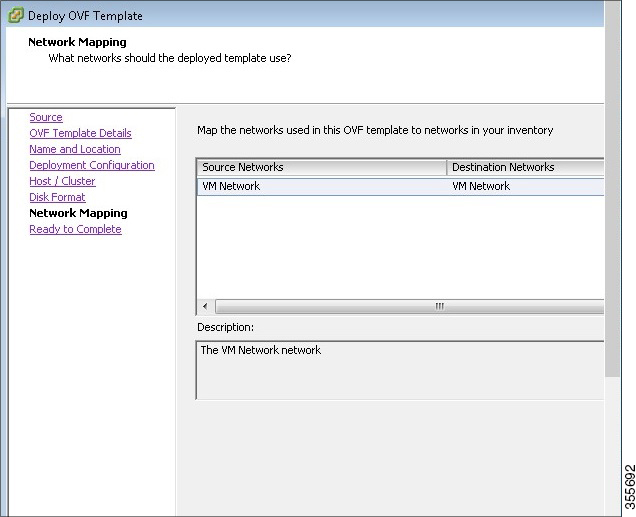
a.![]() Choose the required network mapping settings for your system.
Choose the required network mapping settings for your system.
Step 24![]() The Ready to Complete window appears (Figure 4-24), where you can verify the details of your deployment.
The Ready to Complete window appears (Figure 4-24), where you can verify the details of your deployment.
Figure 4-24 Ready to Complete Window
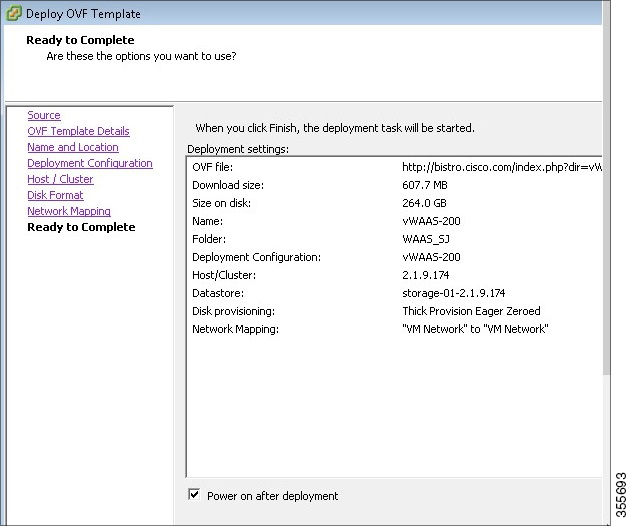
a.![]() If the displayed details are the ones you have specified for your deployment, click the Power on after deployment check box.
If the displayed details are the ones you have specified for your deployment, click the Power on after deployment check box.
b.![]() To start the deployment task, click Finish.
To start the deployment task, click Finish.
Step 25![]() The Status window appears while the OVA file is being deployed (Figure 4-25) and then shows a completion message after the deployment has completed successfully (Figure 4-26).
The Status window appears while the OVA file is being deployed (Figure 4-25) and then shows a completion message after the deployment has completed successfully (Figure 4-26).
Figure 4-25 Deployment In Progress Status Window
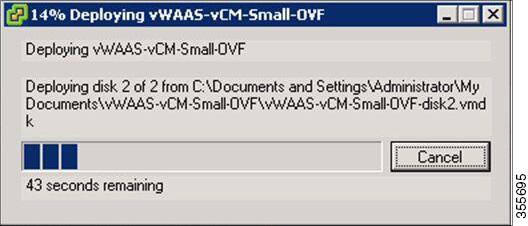
Figure 4-26 Deployment Completion Status Window

a.![]() After deployment is completed, click Close.
After deployment is completed, click Close.
Step 26![]() Navigate to Home > Inventory > Hosts and Clusters. The Inventory panel now shows the newly deployed device.
Navigate to Home > Inventory > Hosts and Clusters. The Inventory panel now shows the newly deployed device.
Step 27![]() Highlight the newly deployed device and open the Console window to display this device (Figure 4-27).
Highlight the newly deployed device and open the Console window to display this device (Figure 4-27).
Figure 4-27 Console Window Displaying Newly Deployed Device
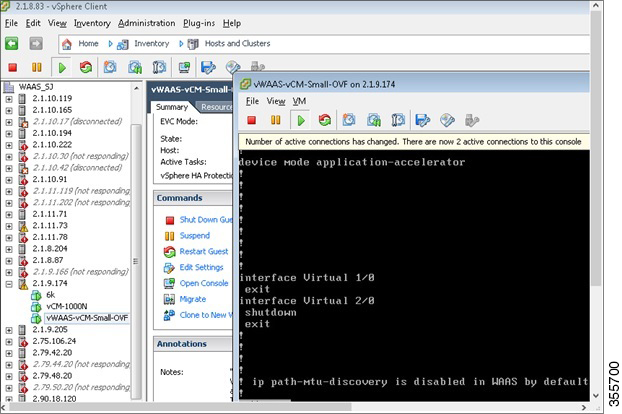
Upgrade/Downgrade Guidelines for vWAAS on VMware ESXi
Consider the following guidelines when upgrading or downgrading your WAAS system with vWAAS on VMware ESXi:
- When upgrading vWAAS, do not upgrade more than five vWAAS nodes at the same time on a single UCS box. Upgrading more than five vWAAS nodes at the same time may cause the vWAAS devices to go offline and into diskless mode.
- If the virtual host was created using an OVA file of vWAAS for WAAS Version 5.0 or earlier, and you have upgraded vWAAS within WAAS, you must verify that the SCSI Controller Type is set to VMware Paravirtual. Otherwise, vWAAS will boot with no disk available and will fail to load the specified configuration.
If needed, change the SCSI controller type to VMware Paravirtual by following these steps:
b.![]() From the VMware vCenter, navigate to vSphere Client > Edit Settings > Hardware.
From the VMware vCenter, navigate to vSphere Client > Edit Settings > Hardware.
d.![]() From the Change Type drop-down list, verify that the SCSI Controller Type is set to VMware Paravirtual. If this is not the case, choose VMware Paravirtual.
From the Change Type drop-down list, verify that the SCSI Controller Type is set to VMware Paravirtual. If this is not the case, choose VMware Paravirtual.
 Feedback
Feedback